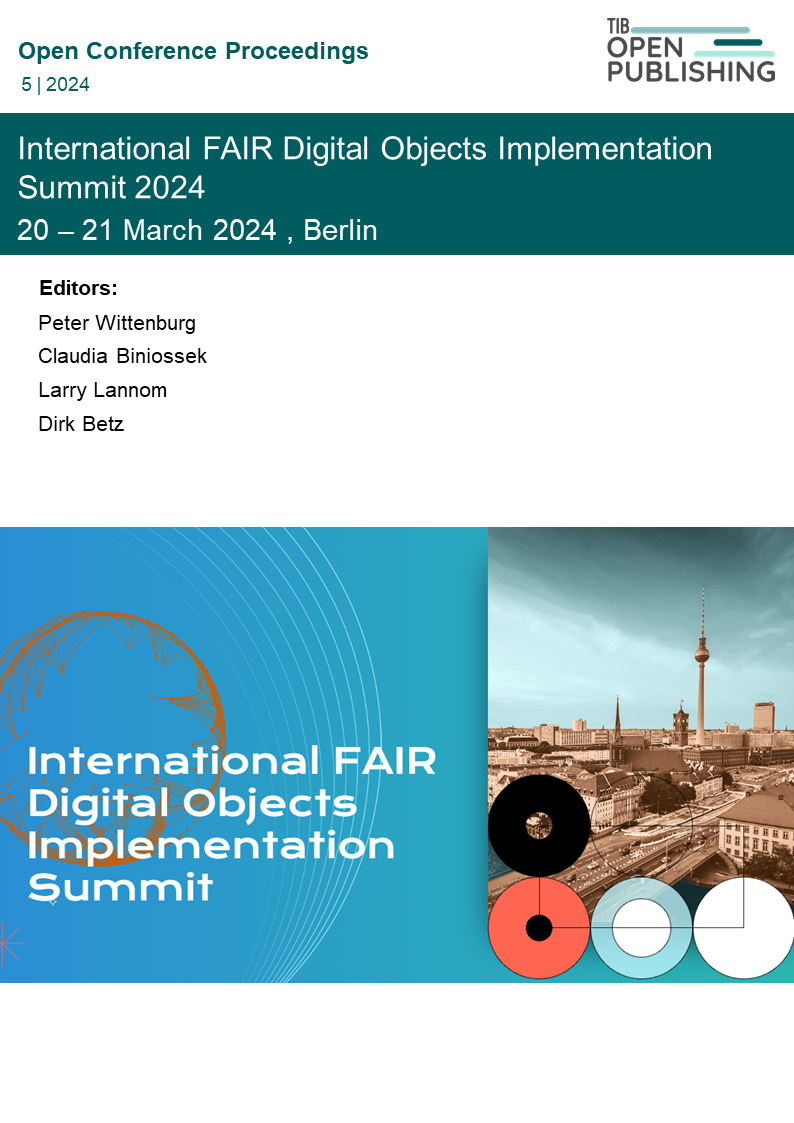FAIR Digital Objects in Autosubmit Workflows
DOI:
https://doi.org/10.52825/ocp.v5i.1416Keywords:
Climate Models, Weather Models, Workflows, Workflow Management, Autosubmit, RO-Crate, FDOAbstract
Climate and weather models are, respectively, complex computer programs used to better understand and predict the climate and to forecast weather. Running these programs involves a series of tasks that may require the use of other computer programs and scripts to prepare the input data, replace values in configuration files (e.g. Fortran namelists), prepare parameters for a batch server used in a high-performance computing facility (e.g. Slurm user configuration, project details, job request, etc.), among other possible variables. There are multiple challenges to make these programs and their outputs FAIR (Findable, Accessible, Interoperable, and Reusable) digital objects. The use of computational workflows executed with workflow managers eases the configuration and execution of climate and weather models, encapsulating some of its complexity, and contributes to a more uniform collection of provenance information about the execution of these models. In this article we focus on Autosubmit, an experiment and workflow manager used for running weather, air quality, and climate experiments that implements the Workflow Run RO-Crate profile to archive provenance information. We also highlight points that are not covered by RO-Crate and explain how we plan to address these shortcomings through recommendations found in FDO specifications.
Downloads
References
[1] I. Anders, K. P. Gehlen, and H. Thiemann, “Canonical Workflows in Simulation-based Climate Sciences,” Data Intelligence, vol. 4, no. 2, pp. 212–225, Apr. 2022, doi: 10.1162/dint_a_00127.
[2] C. Tebaldi, “The use of the multi-model ensemble in probabilistic climate projections,” Philosophical transactions of the Royal Society of London, vol. 365, no. 1857, Jun. 2007, doi: 10.1098/rsta.2007.2076.
[3] D. Manubens-Gil, J. Vegas-Regidor, C. Prodhomme, O. Mula-Valls, and F. J. Doblas-Reyes, “Seamless management of ensemble climate prediction experiments on HPC platforms,” in 2016 International Conference on High Performance Computing & Simula-tion (HPCS), 2016, pp. 895–900. doi: 10.1109/HPCSim.2016.7568429.
[4] A. Bahra, Managing work flows with ecFlow. ECMWF, 2011, pp. 30–32. doi: 10.21957/nr843dob.
[5] H. Oliver et al., “Workflow Automation for Cycling Systems,” Computing in Science & Engineering, vol. 21, no. 4, pp. 7–21, 2019, doi: 10.1109/MCSE.2019.2906593.
[6] F. Massonnet, M. Ménégoz, M. Acosta, X. Yepes-Arbós, E. Exarchou, and F. J. Doblas-Reyes, “Replicability of the EC-Earth3 Earth system model under a change in computing environment,” Geoscientific Model Development, vol. 13, no. 3, pp. 1165–1178, 2020, doi: 10.5194/gmd-13-1165-2020.
[7] M. Klose et al., “Mineral dust cycle in the Multiscale Online Nonhydrostatic AtmospheRe CHemistry model (MONARCH) Version 2.0,” Geoscientific Model Development, vol. 14, no. 10, pp. 6403–6444, 2021, doi: 10.5194/gmd-14-6403-2021.
[8] European Centre for Medium-Range Weather Forecasts - ECMWF, “IFS DOCUMEN-TATION - Cy48r1 Operational implementation 27 June 2023. PART VI: TECHNICAL AND COMPUTATIONAL PROCEDURES.,” pp. 40–48, Jun. 2023, Accessed: Jul. 02, 2024. [Online]. Available: https://www.ecmwf.int/sites/default/files/elibrary/2023/81372-ifs-documentation-cy48r1-part-vi-technical-and-computational-procedures.pdf
[9] M. Bush et al., “The second Met Office Unified Model–JULES Regional Atmosphere and Land configuration, RAL2,” Geoscientific Model Development, vol. 16, no. 6, pp. 1713–1734, 2023, doi: 10.5194/gmd-16-1713-2023.
[10] R. Santana et al., “Wave forecast investigations on downscaling, source terms, and tides for Aotearoa New Zealand,” Geoscientific Model Development Discussions, vol. 2024, pp. 1–35, 2024, doi: 10.5194/gmd-2024-110.
[11] J. Freire, D. Koop, E. Santos, and C. T. Silva, “Provenance for Computational Tasks: A Survey,” Computing in Science & Engineering, vol. 10, no. 3, pp. 11–21, 2008, doi: 10.1109/MCSE.2008.79.
[12] S. Leo et al., “Recording provenance of workflow runs with RO-Crate,” PLOS ONE, vol. 19, no. 9, p. e0309210, Sep. 2024, doi: 10.1371/journal.pone.0309210.
[13] W. Claus, I. Sharif, B. Daan, A. Ivonneand W. Peter, “FDO Machine Actionability”, Nov. 2022, doi: 10.5281/zenodo.7825650.
[14] M. Sporny, D. Longley, G. Kellogg, M. Lanthaler, P.-A. Champin, and N. Lindström, “JSON-LD 1.1. A JSON-based Serialization for Linked Data.,” W3C, Jul. 2020. Available: https://www.w3.org/TR/json-ld11/
[15] L. Moreau et al., PROV-DM: The PROV Data Model. W3C. 2013. Accessed: Jul. 4th, 2024. Available: https://www.w3.org/TR/2013/REC-prov-dm-20130430/
[16] J. Bedia, D. San-Martín, M. Iturbide, S. Herrera, R. Manzanas, and J. M. Gutiérrez, “The METACLIP semantic provenance framework for climate products”, Environmental Mod-elling & Software, vol. 119, pp. 445–457, 2019, doi: 10.1016/j.envsoft.2019.07.005.
[17] N. Pérez-Zanón et al., “SUNSET: SUbseasoNal to decadal climate forecast post-processIng and asSEssmenT suite”, presented at EMS Annual Meeting 2024, Barcelona, Spain, Sep. 1–6, 2024, abstract EMS2024-361, doi: 10.5194/ems2024-361.
[18] FAIR Digital Objects Forum. “Specifications”. Accessed: Jul. 2, 2024. Available: https://fairdo.org/specifications/
[19] A. Ivonne et al., “FAIR Digital Object Technical Overview”, Apr. 2023, doi: 10.5281/zenodo.7824714.
[20] H. Van de Sompel, FAIR Digital Objects and FAIR Signposting. Zenodo, 2023. doi: 10.5281/zenodo.7977333.
[21] A. Ivonne et al., “FDO PID Profiles & Attributes”, Oct. 2022, doi: 10.5281/zenodo.7825630.
[22] B. Christophe, H. Maggie, L. Larry, P. Andreas, S. Ulrichand W. Peter, “Implementation of Attributes, Types, Profiles and Registries”, Mar. 2023, doi: 10.5281/zenodo.7825573.
[23] European Centre for Medium-Range Weather Forecasts - ECMWF. “The Fast Develop-ment of DestinE’s Climate Change Adaptation Digital Twin.” Destination Earth, 19 Jul. 2024, https://destine.ecmwf.int/news/the-fast-development-of-destines-climate-change-adaptation-digital-twin/. Accessed 3 Jul. 2024.
Downloads
Published
How to Cite
Conference Proceedings Volume
Section
License
Copyright (c) 2025 Bruno de Paula Kinoshita, Edgar Garriga Nogales, Manuel Giménez de Castro Marciani, Miguel Castrillo Melguizo

This work is licensed under a Creative Commons Attribution 4.0 International License.
Accepted 2025-02-15
Published 2025-03-18
